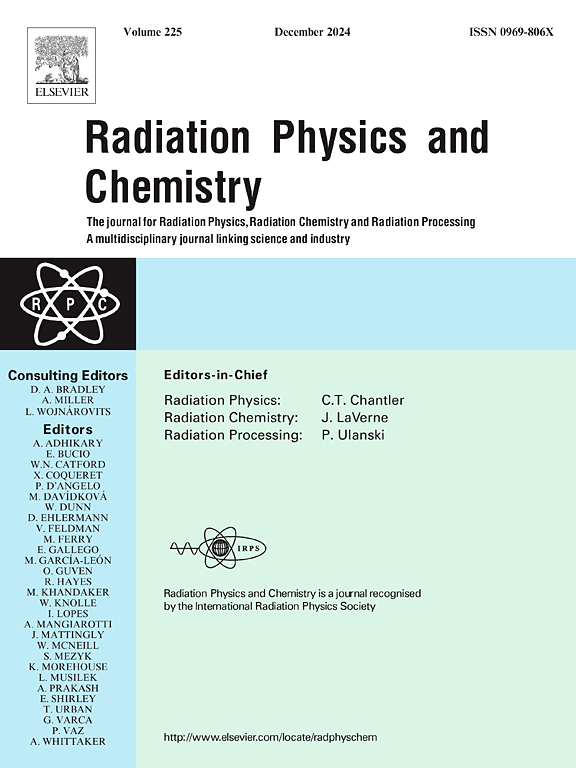基于蒙特卡罗研究的碘131灭活SARS-CoV-2技术的建议
IF 2.8
3区 物理与天体物理
Q3 CHEMISTRY, PHYSICAL
引用次数: 0
摘要
多年来,电离辐射一直用于研制病毒疫苗。最近的研究表明,γ辐射在剂量≥6 kGy时可有效灭活SARS-CoV-2。在这项研究中,我们提出了一种用碘-131 (I-131)灭活SARS-CoV-2的β−方法。利用FreeCad软件,设计了5个半径不同的四层空心球体。最内层是一个实心球体,含有5cc的30mci -131。第二层由0.2毫米厚的石墨烯壁组成,将I-131与病毒样本分开。第三层设计容纳1、2、3、4或5cc的病毒样本。外层也是一层石墨烯壁,作为保护病毒样本的外表面。我们使用InterDosi 1.4代码对选定的病毒样本进行s值估计,并将ICRP成年男性血液作为分配给病毒样本的材料。了解到SARS-CoV-2在4°C冷藏21天后可以存活,我们计算了I-131在同一时期或更短时间内的累积活性。然后用s值乘以累积活度来估计平均吸收剂量。我们的研究结果表明,用5毫升30 mCi I-131处理的1毫升病毒样本获得了最高的s值,使其成为所检查的最有效的几何构型。此外,研究表明,单剂量的I-131可以在一个月的时间内连续灭活4个1毫升的病毒样本。我们得出的结论是,像I-131这样的β -发射放射性核素可以作为灭活SARS-CoV-2的有效替代品。本文章由计算机程序翻译,如有差异,请以英文原文为准。
Proposal for an Iodine-131-based technique derived from a Monte Carlo study for inactivating SARS-CoV-2
Ionizing radiation has been used for many years in the development of vaccines against viruses. Recent studies have shown that γ radiation can effectively inactivate SARS-CoV-2 at doses ≥6 kGy. In this study, we proposed a β− inactivation method for SARS-CoV-2 using the Iodine-131 (I-131). Using FreeCad software, we designed five four-layered hollow spheres with varying radii. The innermost layer is a solid sphere containing 5 cc of a 30 mCi I-131. The second layer consists of a 0.2 mm thick aerographene wall that separates the I-131 from the viral sample. The third layer is designed to accommodate 1, 2, 3, 4, or 5 cc of the viral sample. The outer layer is also a aerographene wall that serves as an external surface to protect the viral samples. We estimated the S-values for the selected viral samples using InterDosi 1.4 code, with ICRP adult male blood as the material assigned to the viral samples. Knowing that the SARS-CoV-2 can be viable when refrigerated at 4 °C for 21 days, we calculated the cumulative activity of I-131 in that same period or less. The mean absorbed dose was then estimated by multiplying the S-value by the cumulative activity. Our findings reveal that a 1 cc viral sample treated with 5 cc of 30 mCi I-131 achieved the highest S-value establishing it as the most effective geometric configuration examined. Furthermore, the study indicated that a single dose of I-131 can sequentially inactivate four 1 cc viral samples over a period of a month. We concluded that beta-emitting radionuclides like I-131 could serve as effective alternatives for inactivating SARS-CoV-2.
求助全文
通过发布文献求助,成功后即可免费获取论文全文。
去求助
来源期刊

Radiation Physics and Chemistry
化学-核科学技术
CiteScore
5.60
自引率
17.20%
发文量
574
审稿时长
12 weeks
期刊介绍:
Radiation Physics and Chemistry is a multidisciplinary journal that provides a medium for publication of substantial and original papers, reviews, and short communications which focus on research and developments involving ionizing radiation in radiation physics, radiation chemistry and radiation processing.
The journal aims to publish papers with significance to an international audience, containing substantial novelty and scientific impact. The Editors reserve the rights to reject, with or without external review, papers that do not meet these criteria. This could include papers that are very similar to previous publications, only with changed target substrates, employed materials, analyzed sites and experimental methods, report results without presenting new insights and/or hypothesis testing, or do not focus on the radiation effects.
 求助内容:
求助内容: 应助结果提醒方式:
应助结果提醒方式:


